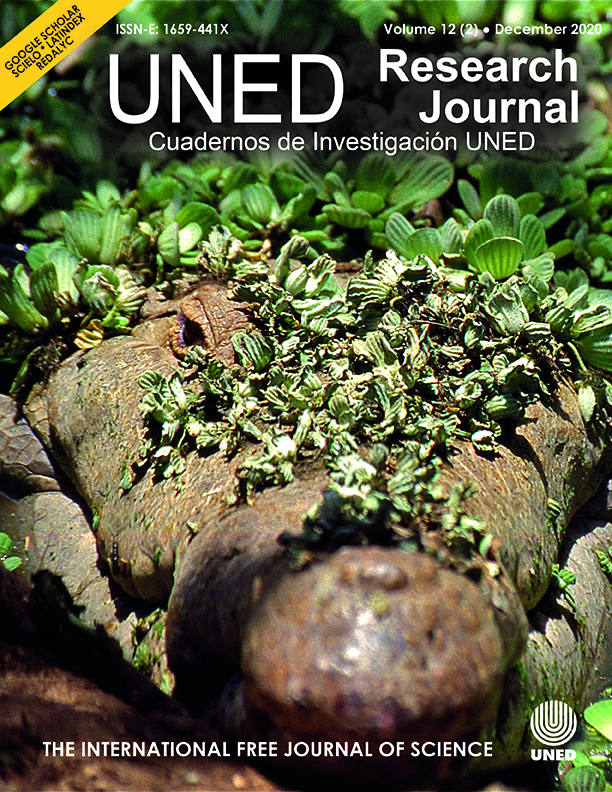Identificación individual del Crocodylus intermedius (Caimán del Orinoco) utilizando el patrón de manchas en la cola.
DOI:
https://doi.org/10.22458/urj.v12i2.3140Palabras clave:
Conservación, Manejo, Identificación de individuos, Crocodylus intermedius, Marcaje-recapturaResumen
Introducción: El Plan de acción para la conservación del caimán del Orinoco (Crocodylus intermedius) entre sus actividades está la liberación de las poblaciones naturales con ejemplares criados en cautiverio, por medio del seguimiento de dichos ejemplares en su hábitat natural se evalúa su adaptabilidad, pero es necesario un sistema de identificación que permita reconocer los ejemplares cuando son recapturados. Objetivo: Determinar si el método de identificación de cocodrilos propuestos por Swanepoel o Boucher et al. es aplicable en el caimán del Orinoco. Metodología: Se fotografiaron 543 caimanes de Orinoco y cada foto se vectorizó dibujando puntos oscuros mayores al 25% en cada escama, en las primeras 10 líneas de escamas dobles caudales de la cola en el lado derecho, se usaron dos sistema de codificación, uno es un código numérico descrito por Swanepoel y el otro es un código aditivo descrito por Boucher et al. Resultados: Se generaron 464 códigos Swanepoel y 537 códigos Boucher et al. basado en el patrón de coloración oscura de las escamas del lado derecho de las colas. Ambos métodos arrojaron altos valores de códigos, sin embargo funciono mejor el desarrollado por Boucher et al., con un 98,90% de diferenciación de los ejemplares analizados. Conclusión: El estudio ratifica que utilizar el método de las manchas en la cola de los cocodrilos es una herramienta eficaz en la identificación de los individuos.
Citas
Boucher, M., M. Tellez and J. T. Anderson. (2017). A tail of two crocs: coding tail-spot patterns of individual identification of American (Crocodylus acutus) and Morelet’s (Crocodylus moreletii) crocodiles. Mesoamerican Herpetology 4(4):760-772.
Brazaitis, P. (1973). Identification of living crocodilians. Zoologica 58(1-4):58-102.
GECV. (2007). Estrategia nacional para la conservación del caimán del Orinoco en Venezuela y su Plan de Acción. En: III Taller para la conservación del caimán del Orinoco. Biollania edición especial N8: 77-86.
Cites. (1995). Identification guide-crocodilians. 1995. Environment Canada, Otawa and CITES Secretariat, Geneva.
Forero, M., J. Lozano & S. Balaguera-Reyna. (2019). Individual identification automation in Crocodilians throught imagery processing: American crocodile as a study case. SPIEDigital Library org/conference proceeding of spie.
Garcia-Grajales, J., A. Buenrostro & P. R. Tellez-Rodriguez. (2009). Variación de patrón de escutelación nucal del cocodrilo americano (Crocodylus acutus Cuvier 1807) en La Ventanilla, Oaxaca, México. Acta Zoológica Mexicana (n. s.), 25(2): 375-382.
Garrick, L. D. (1982). Variation in postoccipital and nuchal scale patterns of American crocodiles (Crocodylus acutus). Am. Zool. 22(4):906.
Platt, S., J. Thorbjarnarson & T. Rainwater. (2012). Scalation of the American crocodile, Crocodylus acutus (Crocodylidae, Crocodylia), from the coastal zone of northern Belize. Caribbean Journal of Science. 46(2-3):332-338.
Seijas, A. E. (2002). Scale patterns of American crocodile (Crocodylus acutus) from several Venezuelan localities. Rev. Unell. Cien. Tec. 20:188-134.
Swanepoel, D. G. J. (1996). Identification of the Nile crocodile Crocodylus niloticus by the use of natural tail marks. Koedoe. 39/1:113-115.
Velasco, A. (2003). Plan de acción para la conservación del caimán del Orinoco (Crocodylus intermedius). Oficina Nacional de la Diversidad Biológica, Ministerio del Ambiente y de los Recursos Naturales. Mimografiado. 14 pp.
Descargas
Publicado
Cómo citar
Número
Sección
Licencia
Nota: Este resumen contiene un copyright incorrecto debido a problemas técnicos. Los autores que publican en esta revista aceptan los siguientes términos: Los autores conservan los derechos de autor y otorgan a la revista el derecho de primera publicación, con la obra simultáneamente bajo una Licencia de Atribución de Creative Commons que permite a otros compartir la obra con el reconocimiento de la autoría y la publicación inicial en esta revista.
Los contenidos se pueden reproducir citando la fuente según la licencia de Acceso Abierto CC BY 4.0. El almacenamiento automático en repositorios está permitido para todas las versiones. Incentivamos a los autores a publicar los datos originales y bitácoras en repositorios públicos, y a incluir los enlaces en todos los borradores para que los revisores y lectores puedan consultarlos en cualquier momento.
La revista está financiada con fondos públicos a través de la Universidad Estatal a Distancia. La independencia editorial y el cumplimiento ético están garantizados por la Comisión de Editores y Directores de Revistas de la UNED. No publicamos pautas publicitarias pagadas ni recibimos financiamiento de la empresa privada.
